
The nickelodeon was the first type of indoor exhibition space dedicated to showing projected motion pictures in the United States and Canada. Usually set up in converted storefronts, these small, simple theaters charged five cents for admission and flourished from about 1905 to 1915.

Universal City Studios LLC, doing business as Universal Pictures is an American film production and distribution company owned by NBCUniversal, a division of Comcast.
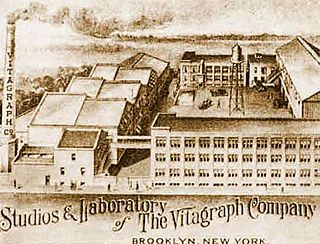
Vitagraph Studios, also known as the Vitagraph Company of America, was a United States motion picture studio. It was founded by J. Stuart Blackton and Albert E. Smith in 1897 in Brooklyn, New York, as the American Vitagraph Company. By 1907, it was the most prolific American film production company, producing many famous silent films. It was bought by Warner Bros. in 1925.

Carl Laemmle was a German-American film producer and the co-founder and, until 1934, owner of Universal Pictures. He produced or worked on over 400 films.

Patrick Anthony Powers was an American producer who was involved in the movie and animation industry of the 1910s, 1920s, and 1930s as a distributor and producer. His firm, Celebrity Productions, was the first distributor of Walt Disney's Mickey Mouse cartoons (1928–1929). After one year, Disney split with Powers, who started another animation studio with Disney's lead animator, Ub Iwerks.
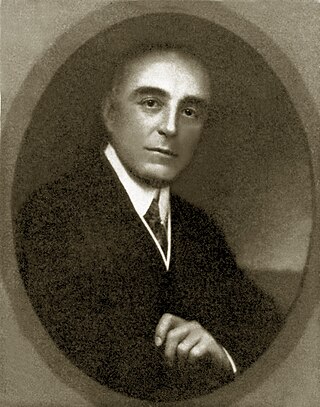
Pierre Ernest Jules Brulatour was a pioneering executive figure in American silent cinema. Beginning as American distribution representative for Lumiere Brothers raw film stock in 1907, he joined producer Carl Laemmle in forming the Motion Picture Distributing and Sales Company in 1909, effectively weakening the stronghold of the Motion Picture Patents Company, headed by Thomas Edison, a large trust company that was then monopolizing the American film industry through contracts with hand-picked, established studios. By 1911 Brulatour was president of the Sales Company. He was a founder of the Universal Film Manufacturing Company, later known as Universal Pictures.
Film distribution, also called film exhibition or film distribution and exhibition, is the process of making a movie available for viewing by an audience. This is normally the task of a professional film distributor, who would determine the marketing and release strategy for the film, the media by which a film is to be exhibited or made available for viewing and other matters. The film may be exhibited directly to the public either through a movie theater or television, or personal home viewing. For commercial projects, film distribution is usually accompanied by film promotion.
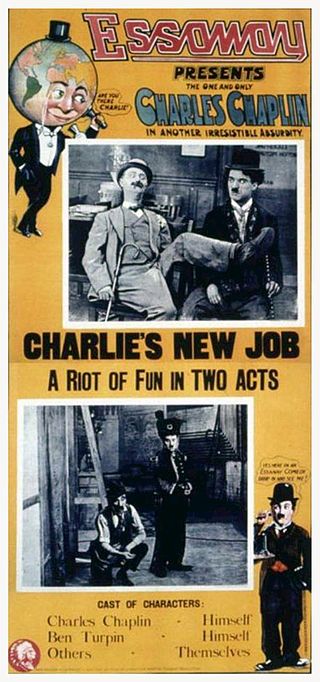
The Chicago film industry is a central hub for motion picture production and exhibition that was established before Hollywood became the undisputed capital of film making. In the early 1900s, Chicago boasted the greatest number of production companies and filmmakers. Essanay Studios founded by George K. Spoor was one of the earliest successful studios to produce movies in Chicago, employing stars such as Charlie Chaplin and Gloria Swanson. Actor and co-founder of Essanay Studios, Broncho Billy Anderson gave birth to the western genre. Early film companies such as Essanay Studios produced multiple silent films every week and rented viewing equipment to showcase the latest cinematography to the public. This rental culture gave birth to the popularity of Nickelodeons up until the Great Depression. However, due to the high demand for motion pictures during this time, a black market for films and equipment developed. The Motion Picture Patents Company, established in 1909 as a conglomerate of the major studios, sought to eliminate all illegal use of patented film equipment. As a result, independent ventures entered the film scene. Independents drove the film industry to the west to avoid legal trouble with the trust of major film companies united under the Motion Picture Patents Company. The west offered fairer weather and scenery that better accommodated film making. Not until the 1980s and early 21st century has Chicago experienced a film production revival. Blockbusters, such as Blues Brothers, Sixteen Candles, and The Dark Knight, have rejuvenated the Chicago film scene.

Laemmle Theatres is a group of family-run arthouse movie theaters in the Los Angeles area. It was established in 1938 and is owned and operated by Robert Laemmle and his son Greg Laemmle.

The Restless Spirit is a 1913 American silent short drama film written and directed by Allan Dwan, featuring J. Warren Kerrigan, Lon Chaney, and Pauline Bush. The film is based on Thomas Gray's 1751 poem, Elegy Written in a Country Churchyard, and tells the story of a man who wishes to be a conqueror. A series of illusions follows which show him the futility of conquest when he cannot even conquer his own community.

Who's Your Neighbor? is a 1917 silent American propaganda and drama film directed by S. Rankin Drew. The film's plot focuses around reformers who pass a law to force prostitutes, including Hattie Fenshaw, out of the red light district. Fenshaw becomes Bryant Harding's mistress and lives in an apartment next door to a reformer, and continues to ply her trade. After Fenshaw becomes familiar with Harding, his son, daughter and the daughter's fiancé, the climax of the film occurs as the cast assembles at Fenshaw's apartment. Harding returns and a fight breaks out that results in the reformers' arrival and concludes with the presumption that Fenshaw returns to a place of "legalized vice". The drama was written by Willard Mack and was his first foray into screen dramas. The film proved controversial, but is noted as a great success. The film originally debuted on June 15, 1917, but it was rejected by the National Board of Review and was later approved after a revision, but the film continued to be labeled as an immoral production. The film is presumed to be lost.

Motography was an American film journal that was first published in 1909 and ran until mid-1918. The magazine was published in 1909 and was originally named The Nickelodeon, but then changed its name to Motography in 1911. The trade journal was published monthly by Electricity Magazine Corporation in Chicago and had a bureau office in New York City. Motography was one of the most popular American Film trade papers, and was read primarily by individuals in the film industry, such as movie directors and movie theater owners. In 1918, Martin Quigley bought Motography merging it with what eventually became the Motion Picture Herald.

The Right to Be Happy is an American silent film from 1916 that draws inspiration from Charles Dickens' 1843 Novella, A Christmas Carol. This film was Universal's first attempt at making a Feature film based on Dickens' novella. Throughout the silent era, it stood as the first and only feature film adaptation of A Christmas Carol by an American or foreign film company. The movie was directed by Rupert Julian and supported by a cast of Universal Bluebird players, including Rupert Julian, Claire McDowell, and Harry Carter.
William H. Clune was an American railroad property developer, film exchange and then theater chain owner, film studio owner, and film producer.

John Rudolph Freuler was an American businessman in the film industry who owned theaters, film exchanges, and film studios. He signed Charlie Chaplin to a lucrative contract at Mutual Film. Later in his career he owned Monarch Films studio. The Chicago History Museum has a collection of his papers.
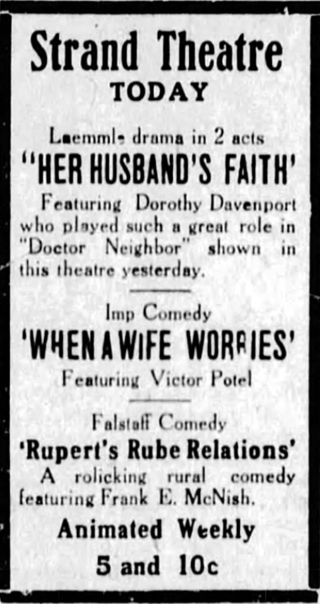
Her Husband's Faith is a 1916 American silent short film directed by Lloyd B. Carleton. The film is based on a story by Paul Machette. Eugene De Rue developed the screenplay. This domestic society drama's features Dorothy Davenport, T. D. Crittenden and Emory Johnson.

Trying to Get Arrested is a 1909 American comedy short film directed by D. W. Griffith, produced by the Biograph Company of New York City, and starring John R. Cumpson. Filmed in two days in early 1909 at Palisades Park, New Jersey, it was released in April that year and distributed to theaters on a "split reel", which was a single film reel that included more than one motion picture. The other picture that accompanied this comedy was the Biograph "dramedy" The Road to the Heart.

The Road to the Heart is a 1909 American short film, a dramedy directed by D. W. Griffith and produced by the Biograph Company of New York City. Starring David Miles, Anita Hendrie and Herbert Yost, the production was filmed in two days in March 1909 at Biograph's studio in Manhattan. It was released in April that year and distributed to theaters on a "split-reel", which was a single film reel that included more than one motion picture. The other picture that accompanied this comedy was the Biograph comedy Trying to Get Arrested.

The Unattainable is a 1916 American Blank and White silent drama directed by Lloyd B. Carleton. The film is based on the story by Elwood D. Henning. The photoplay stars Dorothy Davenport and Emory Johnson.
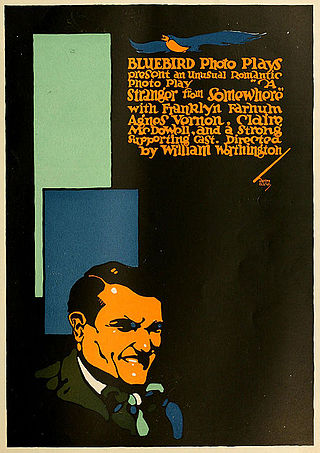
A Stranger from Somewhere is a 1916 silent film directed by William Worthington. Universal's Bluebird Photoplays division produced and distributed the film. The movie featured Franklyn Farnum, Agnes Vernon, Barney Furey, and Claire McDowell. The screenplay was written by F. McGrew Willis and Walter Woods who were credited under the pseudonym Willis Woods.


















